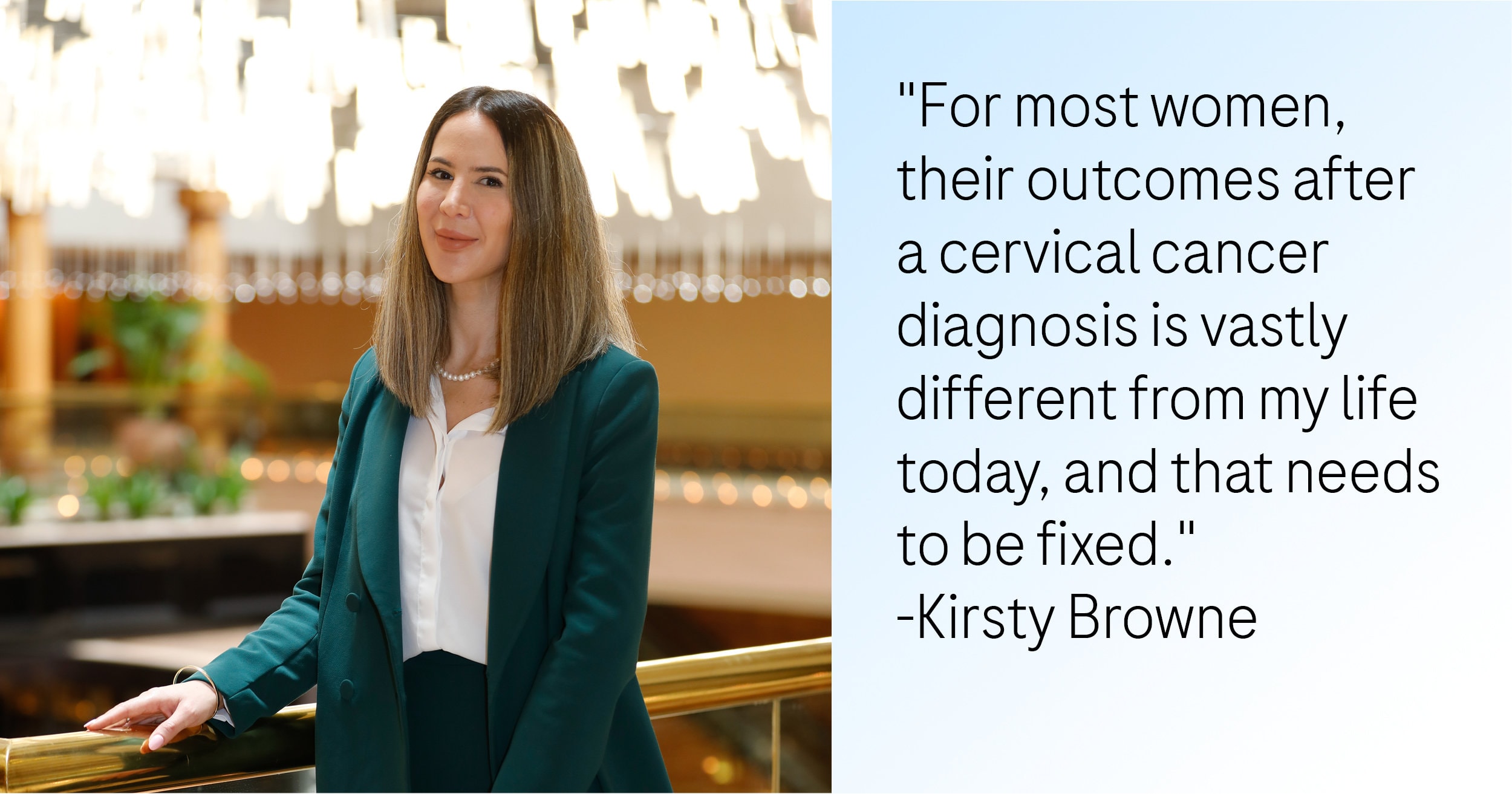Kirsty Browne shares her passion for being a cervical cancer screening advocate and her journey through battling this disease.
“When I was 26, my world turned inside out overnight. I was completing the final year of my pharmacy degree and studying hard for the pharmaceutical intern exam. This was when I was also told I had a rare type of cervical cancer,” says Kirsty Browne, a cervical cancer survivor, now advocate for cervical cancer screening.
A pharmacist-in-training at the time, the value of screening was not lost on Kirsty. Having been proactive with her cervical cancer screenings and vaccinations, this diagnosis was definitely a surprise, and not a pleasant one.
Recounting the experience, Kirsty describes her emotions at the time: “At 26, this isn’t something you’re thinking about. My mind was a mess, all these thoughts running through my mind…
It can’t be me.
This must be a mistake!
Will I be ok?
Who will want to be with me after this?
Will I ever get married?
Will I be able to have a baby?
Everything started to spiral. It was a bizarre period of time – trying to wrap my head around what was going on in my body, and having to make quick decisions about things that my life literally depended on.”
Sadly, this isn’t a unique experience. Cervical cancer is one of the most preventable cancers today, with a potential to eliminate cervical cancer incidences in our lifetime. Yet, it remains a leading cause of death in women worldwide, with one woman succumbing to the disease every 2 minutes. Cervical cancer is the fourth most frequent cancer in women with more than 600 000 new cases in 2020 and more than 302,000 deaths from cervical cancer in 2020.1
Unlike the majority of cancers, the main cause of cervical cancer is well known with almost all cases caused by the human papillomavirus (HPV), which infects most men and women at some point in their lives.
In 2018, the World Health Organization (WHO) had a global call to action for the elimination of cervical cancer by 2030. The WHO recommends a ‘90-70-90’ approach that involves three key pillars: vaccination, screening and treatment.
The critical role of screening
Part of the WHO’s 90-70-90 target is to ensure 70% of women would be screened with a high performance test by age 35 and again by 45. With effective screening, we have the ability to achieve WHO’s target of four or less cases per 100,000 women much earlier.2 Despite efforts, coverage of vaccination or screening is lacking in many parts of the world, including much of the Asia Pacific region. Only four out of 10 ASEAN countries have launched a population-based screening program, with the remaining of women screened opportunistically or not at all.3
Effective cervical cancer screening programmes are worth the investment as they can improve outcomes and reduce costs to health systems and women. The benefits can also extend to the broader economy, with an estimated USD $3.20 return for every dollar spent on intervention measures, and up to USD $26 when this support is extended to broader aspects of a woman’s life.4
The lack of access to screening can be due to many factors, ranging from the lack of financial resources to pay for a test, to the low quality of testing infrastructure within a country. Studies have linked low literacy with poorer health literacy and increased barriers to health access, including low knowledge of health service utilisation and disease symptoms, and lower likelihood of attending health screenings.5 Over 500 million females are illiterate globally, approximately twice the number of men.6 Education therefore, remains a critical first step in ensuring patients are aware of the critical role of screening in maintaining their health, and saving lives.
A call for more equitable healthcare
With Australia leading the way in eliminating cervical cancer by 2030, Kirsty acknowledges the privilege she’s had to receive world-class healthcare at speed. With effective and efficient diagnostics, her doctors were able to provide fertility preserving treatment options that could both save her life, and give her the precious gift of motherhood in the future. Kirsty, however, realises this isn’t the case for most women. “Inequity to care is definitely an issue. Having grown up in South Africa before moving to Australia, the lack of access to quality healthcare is very apparent to me. I know that if I was in another country, my diagnosis, and prognosis would be very different. For most women, their outcomes and quality of life after a cervical cancer diagnosis is vastly different from my life today, and that’s definitely something that needs to be fixed, ” says Kirsty.
Nearly 90% of annual cervical cancer deaths occur in Low and Middle Income Countries (LMICs). With 60% of the LMICs residing in the Asia Pacific region, this is a critical problem for families, societies, and economies.7 With many having little to no access to quality care, improvements to health systems and infrastructure are required to meet the basic needs of patients in developing countries.
With the WHO’s global call for action to eliminate cervical cancer, renewed political will is required to make this a reality. It requires collective action amongst all stakeholders to unite behind this common goal to educate, roll-out vaccination and screening programs, and increase the access of, and accessibility to, effective and efficient healthcare.

Thriving, not just surviving
Thankful for the options that were available to her at the time, Kirsty is living the life she’s always wanted, a life that could very well have been cut short. After going through treatment and coming out cancer free, Kirsty is faced with the question – What now? She recounts: “I have spent the last five years understanding what it means to thrive in this new world post-cancer. Developing a new mindset, being grateful for the opportunities I now have, and for the life I’m living is paramount – I’m now a wife, a mother, and have a fulfilling career. While my journey with cancer is definitely a pivotal chapter in my life, it isn’t all of me. I want my life to be, and mean, so much more.”
Today, Kirsty is a passionate advocate for cervical cancer screening:“Looking back, this experience I’ve had, and knowing that so many women are going through something similar, when it can all be avoided and even eliminated, that just drives me to keep talking about it to anyone who would listen to me.”
A cervical cancer diagnosis doesn’t just affect a woman, nor is it solely a women’s issue. It affects her partner, her children, her community. When asked what her one message to everyone would be, Kirsty says in a heartbeat: “We all know a woman in our life that we care about. We can all do our part to check in on them, remind them to put their health first. I speak about this all the time, and my message is always the same – go and get screened, go and tell a woman you love to get screened. You could very well be saving a life. In the least, you’re doing your part to help eliminate this one cancer that we can all get rid of in our lifetime.”
References:
1World Health Organization. (2022) Fact Sheet on Cervical Cancer. Retrieved from: https://www.who.int/news-room/fact-sheets/detail/cervical-cancer
2Burger, E.A. et al. (2020) “Projected time to elimination of cervical cancer in the USA: A comparative modelling study,” The Lancet Public Health, 5(4). Available at: https://doi.org/10.1016/s2468-2667(20)30006-2.
3Zhao, S. et al. (2022) “Cervical cancer burden, status of implementation and challenges of cervical cancer screening in Association of Southeast Asian Nations (ASEAN) countries,” Cancer Letters, 525, pp. 22–32. Available at: https://doi.org/10.1016/j.canlet.2021.10.036.
4A cervical cancer-free future: First-ever global commitment to eliminate a cancer. World Health Organization. World Health Organization. Available at: https://www.who.int/news/item/17-11-2020-a-cervical-cancer-free-future-first-ever-global-commitment-to-eliminate-a-cancer (Accessed: December 8, 2022).
5Darren A DeWalt, Nancy D Berkman, Stacey Sheridan, Kathleen N Lohr, Michael P Pignone. (). National Center for Biotechnology Information. Literacy and Health Outcomes, A Systematic Review of the Literature. Retrieved from: https://www.ncbi.nlm.nih.gov/pmc/articles/PMC1492599/
6Global Partnership for Education. (2018). 12 years to break down the barriers to girls’ education. Retrieved from: https://www.globalpartnership.org/news/infographic/12-years-break-down-barriers-girls-education
7World Bank. Low & middle-income countries. Data Available at: https://data.worldbank.org/country/XO














